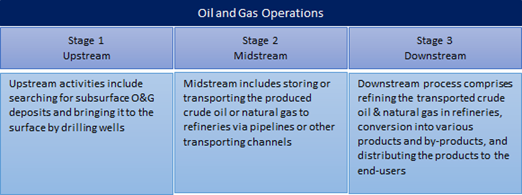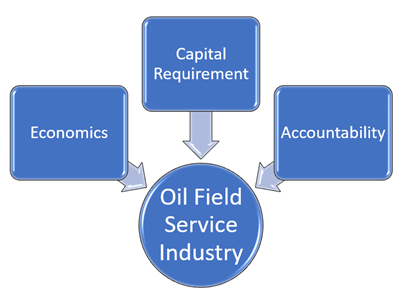The oilfield is a territory of land from where raw petroleum and natural gas is created. It can extend to numerous miles as hydrocarbon reservoirs commonly spread over a massive zone beneath the subsurface. Various oil or gas wells can be drilled in a solitary Oilfield. An Oilfield can be characterised as a surface zone which is on top of the subsurface accumulated hydrocarbon. A hydrocarbon field comprises of a reservoir in a shape that will trap hydrocarbons, and that is covered by an impermeable cap rock.
Understanding Oil Field:
The overall oil and gas industry is classified into three classes that are upstream, midstream and downstream businesses. Upstream deal with the exploration and production of subsurface deposited hydrocarbons whereas mid-stream is related to the transportation of extracted hydrocarbons from their place of origin to the refineries and downstream is pertaining to the processing and further marketing of petroleum products.

Image Source: Kalkine Group Image
Oil field is a part of upstream petroleum business as it consists of multiple wells and oil pools. The wells may be in the production stage or about to drill stage. As endless wells are operational in the oilfield, it contains associated facilities and infrastructure which are required in exploration and production. For example, oil rigs, cementing trucks, drilling mud related apparatus' etc.
Across the globe there are more than 40,000 Oilfields, both onshore and offshore, the largest ones being the Ghawar Field in Saudi Arabia and the Burgan Field in Kuwait.
Oil Field Infrastructure:
Constructing an oil field can be a challenging task. We don't only need drilling equipment, but many associated facilities are also required like accommodation and food facility along with water and electricity for the crew working there. If the oil field lies in a very cold area, there is a requirement to keep the pipelines warm.
In the absence of gas storage facilities at any remote location, the associated gas needs to be flared out so; one must require pipes, furnace and chimneys for that. As a secondary source of recovery, nodding donkeys or pumpjacks are installed to produce more from the reservoir.
Oil field service companies have a long history of supporting E&P companies with an extensive global network of experienced worldwide professionals for both conventional and unconventional fields, including oil sands. The service companies provide support in planning, manufacturing, commissioning, drilling well maintenance, development and other offsite related tasks.
Complications in Oil Field Set-Up:
As stated in the previous section, the whole petroleum industry is divided into three sectors, and most of the companies have expertise in a particular sector of the industry making them dependent on others for other services they don't excel in. On the other hand, there are other types of companies which are known as integrated oil & gas companies which have an expertise of the entire supply chain of an O&G industry, but the numbers are limited.
Frequent technological advancement to effectively extract the technically challenged subsurface deposited hydrocarbon is a critical problem for the organisation. Each company is not able to upgrade itself as per the current requirement, in each and every sector to prove its excellence, thereby creating a dependency on others. New technologies like hydraulic fracturing, tight oil exploration, horizontal drilling have dramatically increased the efficiency in the extraction of O&G. Lowering production cost is the prime objective of any company working in the extraction of hydrocarbon.
Birth of Oil Field Service:
Below are the most significant elements which empowered and improved oilfield service industry that accounts for most of the innovation and advanced skills over the existing pattern of an oil and gas industry.

Image Source: Kalkine Group Image
Economics:
The specialisation of organisations in a specific service domain allows a healthy competition and technical innovation among suppliers. An in-house specialisation of all services from toe to head might not provide an innovative and cost-effective approach which may become a hurdle in the quick ascent of the petroleum technology that the industry has seen in the recent past.
Capital Requirement:
To excel in each and every service, the company requires a lot of capital. Many integrated oil & gas companies may manage it, but most of the companies are not able to invest the enormous amount needed to develop and excel in every field.
Accountability:
Third-party service suppliers seemingly consider extended responsibility and effective profit margin among service provider and receiver. Outsourcing may also lead to greater accountability of the service company in the operational risk, delays in execution and mispricing in a contract.
 Please wait processing your request...
Please wait processing your request...